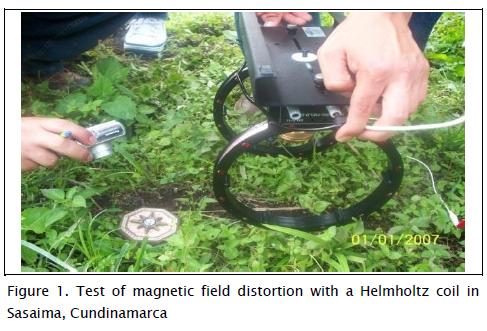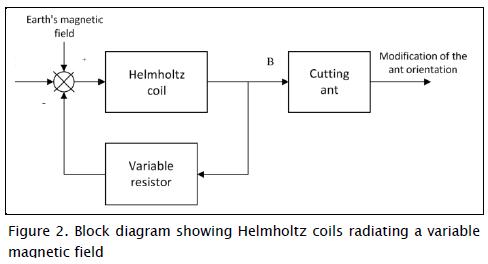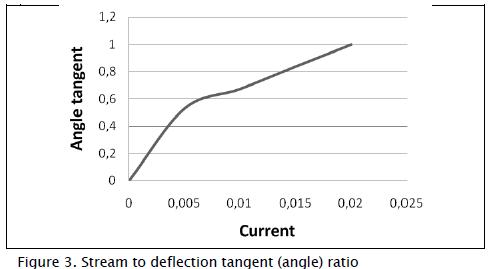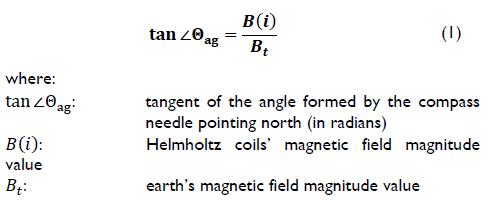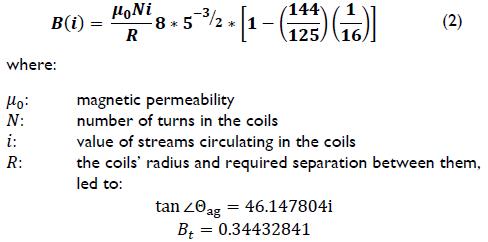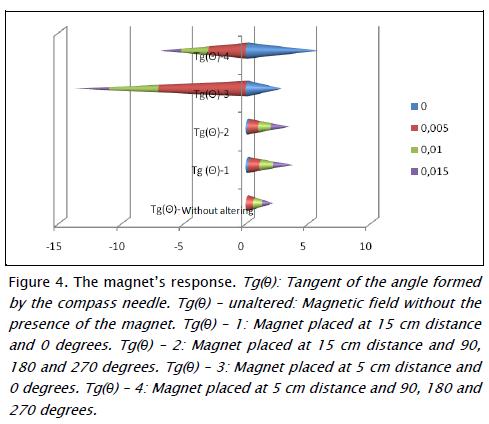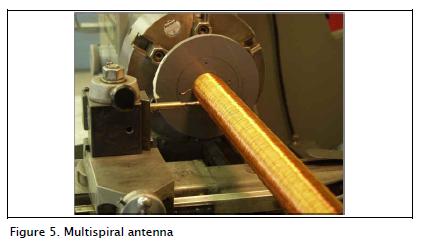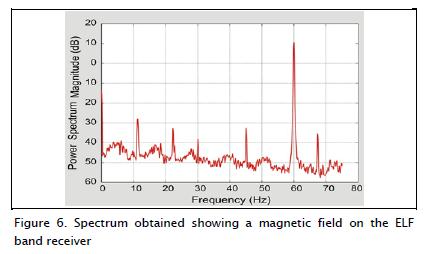Services on Demand
Journal
Article
Indicators
-
 Cited by SciELO
Cited by SciELO -
 Access statistics
Access statistics
Related links
-
 Cited by Google
Cited by Google -
 Similars in
SciELO
Similars in
SciELO -
 Similars in Google
Similars in Google
Share
Ingeniería e Investigación
Print version ISSN 0120-5609
Ing. Investig. vol.32 no.2 Bogotá May/Aug. 2012
Local distortion of the earth's magnetic field as a proposal for handling the leafcutter ant species Atta spp.
(Hymenoptera: Formicidae)
Distorsión local de campo magnético terrestre como una propuesta de manejo de una especie de hormiga arriera Atta spp.
(Hymenoptera: Formicidae)
Paz H.1, Vargas M.A.2, Forero O.A.3, Pabón J.F.4, Plaza J.A.5
1 Hernán Paz Penagos. Affiliation: Escuela Colombiana de Ingeniería Julio Garavito. Electronic Engineer, Universidad Distrital Francisco José de Caldas, Colombia. Licentiate in Philosophy and History, Universidad Santo Tomás, Colombia. MSc. in Teleinformatics, Universidad Distrital Francisco José de Caldas. PhD. candidate in Education, Universidad Pedagógica Nacional, Distrital Francisco José de Caldas and Universidad del Valle, Colombia. E-mail: hernan.paz@escuelaing.edu.co
2 Mauricio Alexander Vargas Rodríguez. Affiliation: Universidad Nacional de Colombia. Electronic Engineer, Escuela Colombiana de Ingeniería Julio Garavito, Colombia. MSc. Candidate in Telecommunication engineering, Universidad Nacional de Colombia, Colombia. E-mail: : mauavargasrod@unal.edu.co
3 Oscar A. Forero Bermúdez. Affiliation: Pontificia Universidad Javeriana, Bogotá Campus. Electronic Engineer, Escuela Colombiana de Ingeniería Julio Garavito, Colombia. MSc. Candidate in Telecommunication engineering, Pontificia Universidad Javeriana, sede Bogotá, Colombia. E-mail: oscaralexanderf@gmail.com
4 Juan Francisco Pabón Caviativa. Affiliation: Escuela Colombiana de Ingeniería Julio Garavito. Electronic Engineer, Escuela Colombiana de Ingeniería Julio Garavito, Colombia.
5 Jovan A. Plaza Martínez. Affiliation: Escuela Colombiana de Ingeniería Julio Garavito. Electronic Engineer, Escuela Colombiana de Ingeniería Julio Garavito, Colombia.
ABSTRACT
Studies regarding the spatial orientation of social insects (bees, termites and ants) concerning their search for food, foraging and transporting it have received considerable attention during the last few years. Such studies have been aimed at learning so as to apply it to robotics (multiagents) and ecological pest control. However, little is known about the types of orientation mechanism and their integration in such insects. This article presents some geomagnetic field detection studies dealing with controlling them by magnetotaxis or orientation experiments in Sasaima (Cundinamarca) to formulate an ecological management proposal for ants from this species which greatly affect Colombian agriculture.
Keywords: Atta spp. leafcutter ant, geomagnetic field, orientation, ecological control
RESUMEN
Los estudios sobre la orientación espacial de los insectos sociales (abejas, termitas y hormigas) en situaciones de búsqueda, recolección y transporte de alimento han recibido considerable atención en los últimos años. Los propósitos han sido aprender acerca de ellos para aplicarlos a la robótica (multiagentes) y al control ecológico de plagas. Sin embargo, aún se conoce poco sobre los tipos de mecanismos de orientación y su integración en dichos insectos. En este artículo se describen algunos estudios sobre orientación de la hormiga mediante campo geomagnético detectado. Los resultados de la investigación profundizan en el análisis de la orientación mediante magnetotaxia o mecanismo de interacción entre el campo geomagnético y la hormiga cortadora o arriera Atta spp. (Hymenoptera: Formicidae), basada en varios experimentos realizados en el municipio de Sasaima (Cundinamarca), con el fin de plantear una propuesta de manejo ecológico de hormigas de esta especie que afectan la agricultura colombiana.
Palabras clave: hormiga arriera Atta spp., campo geomagnético, orientación, control ecológico.
Received: October 22nd 2011 Accepted: May 28th 2012
Introduction
The world contains more than 3,500 species belonging to the Formicidae family; some live in tropical zones and are characterised by their grouping into colonies. There are more than 700 species (87 genera) in Colombia, including 11 types of leafcutter ants, 4 of them belonging to the Atta genera (Rodríguez et al., 2008). These species are concentrated in the Santander, Antioquia, Quindío, Risaralda, Caldas, Cundinamarca, Valle del Cauca, Bolivar and Chocó departments in Colombia.
Leafcutter ants affect cassava, cocoa, coffee, corn, sugarcane and citrus crops, leading to partial or total defoliation of plants according to reports by Lapointe et al., (1990), Fernandez & Jaffe (1995) and Lopez & Orduz (2004). They also cause damage to structures such as houses, buildings and roads due to their tunnelling activities. Government agencies, such as the Instituto Colombiano Agropecuario (ICA), Umata, regional agriculture secretariats and the Colombian Ministry of Agriculture and Rural Development, are responsible for helping Colombian rural-dwellers in controlling leafcutter ants; however, much effort and many resources have been invested in pest management training (i.e. anthill eradication and in situ control of the leafcutter ant) without good results being forthcoming.
This research has thus proposed designing and constructing a very low frequency (VLF) electromagnetic wave (antenna) disturbance system for ecological control of the Atta spp. leafcutter ant which most affects the aforementioned crops, following Ministry of Agriculture recommendations regarding the green flower programme for clean production (Maya, 1990; INIA, 2004). Controlling magnetic wave polarisation can distort the geomagnetic field locally and so confuse ants' movements.
Theoretical
The ants' magnetic orientation by geomagnetic field. The presence of charge in the core of the earth (due to flows of ferrous material), the presence of magnetised rocks in the earth's layers, the interaction of cosmic rays and the influence of magnetospheres of planets and stars close to the earth leads to variation in magnetic field strength at different latitudes and longitudes on the surface. The magnetic field of the earth's surface can be represented by a magnetic dipole having 11.3° inclination regarding the axis of the earth's rotation. Field strength on the earth's surface ranges from less than 30 microtesla (0.3 gauss) in most of South-America and South Africa, to exceeding 60 microtesla (0.6 gauss) in Canada, South Australia and part of Siberia (Deutschlander et al., 1999). Bogotá is located on 3° 36¨ west magnetic declination (i.e. variation), as measured by Pablo Quintero from the Institute Geographic Agustín Codazzi in 1989.
Terrestrial living organisms are born, grow and evolve in the presence of the earth's variable magnetic field and, therefore, there may be an evolutionary advantage in detecting such field for uses having a specific purpose, as in the case of bacteria (Magnetotacticum magnetospirillum), whales, turtles, dolphins, lizards (Pogona vitticeps), shoals of fish, migratory birds and insects (ants, wasps, bees and termites) which detect geomagnetic field variation and store such data as compass orientation (Kermarrec, 1981; Vácha, 1997; Wiltschko & Wiltschko, 1995 ; Wajnberg et al., 2000; Nishimura et al., 2010).
One of the first studies showing ants' sensitivity to magnetic fields was carried out by Kermarrec in 1981; he placed attracting magnets in his laboratory around Acromyrmex octospinosus ants' artificial nests. Kermarrec consistently noted that they avoided the regions near to the magnets. Anderson and Van der Meer made a laboratory study of the Solenopsis invicta ant in 1993 involving an experiment consisting of placing an artificial ants' nest inside a Helmholtz coil to manipulate the geomagnetic field; near it was a dead cockroach as food for the ants. They measured recruitment time from the moment a scout ant approached the cockroach and studied the unchanged geomagnetic field.
Çamlitepe and Stradling's work (1995) showed that ants could use geomagnetic field vector directional information as spatial reference for orientation. They studied Formica rufa ants in the field and laboratory; ants were conditioned to seek food in the direction of magnetic north. When this setting was altered, most ants sought food in the new direction for magnetic north. This meant that ants were able to use the direction and field sense to move towards a specific location.
Three hypotheses have been postulated for understanding magnetoreception mechanisms:
- The ferromagnetic hypothesis involves the presence of magnetic particles as magnetic field transducers;
- Modifying the mechanism of vision by creating chemical moieties in pairs, because of the presence and variation of magnetic fields; and
- Electromagnetic induction, in which magnetic flux varia-tions can produce electric fields and streams of ions. This mechanism has been found in some electric fish.
Concerning the first hypothesis, the type of magnetic particles present in some organisms can be classified by size as follows: multidomain magnetic particles are larger and are characterised by the total configuration of each domain's magnetic moments resulting in low magnetic energy throughout the particle, intermediate size magnetic monodomains can preserve a stable magnetic moment and superparamagnetic particles (the smallest) are characterised by being magnetically unstable because of the external environment's thermal energy.
These particles usually have different magnetic behaviour because whilst the larger ones (multidomain and monodomain) are permanently magnetised, the smaller ones (super paramagnetic) can modify their magnetisation vector and still lose magnetisation through variations in temperature, without moving these particles. The latter, responding quickly to magnetic field variations, are thus able to play the role of sensing magnetic variation in the environment.
According to studies by Hölldobler & Wilson (1990) and Banks & Srygley (2003), Solenopsis sp. ant species have four to ten millionths of an inchlong biomineralased magnetic material particles or magnetite on their bodies (Fe3O4); although such studies led to no major findings, the presence of magnetite in this ant species' abdomens has stimulated ferromagnetic hypotheses to explain their magnetotaxis.
Further research in Pachycondila marginata has confirmed this theory (Esquivel et al., 1999, Acosta et al., 1999). This species has migratory behaviour and lives in south-eastern Brazil. A study of several colonies' annual migration routes has shown a preference for choosing routes in a deviated axis of around 12° of magnetic north-south axis. The results demonstrate this species' ability to use geomagnetic field information during its migration. Measurement of induced magnetisation (magnetometry) with magnetometers coupled to superconducting quantum interference devices (SQUID) has revealed the presence of small particles located in Pachycondila marginata dry, crushed abdomens; such findings show the coexistence of ferromagnetic properties having a super paramagnetic state at room temperature. This implies the existence of magnetic nanoparticle distribution in these ants' abdomens. Wajnberg's et al., (2000) revealed the presence of isolated particles and small agglomerates in the abdomens of the same ant species to complement studying this theory; magnetic volume was comparable to that measured by electron microscopy.
Such interaction between magnetic field and some living beings (some ants, bees, flies, butterflies, turtles, salamanders, salmon, tuna, whales, dolphins, sharks, birds, bacteria and protozoa) supports the concept of magnetotaxis, although little is known about this in some of the aforementioned animals.
Field test
The tests were intended to test Atta spp. ants' sensitivity to an induced magnetic field. The first part of the research took place in the Escuela Colombiana de Ingenieria's laboratories where different intensity and sized magnets were used and their sur-rounding constant fields were measured. Helmholtz coils were used for determining the magnetic field generated at different current variations and different lengths.
The second part began once the magnets and Helmholtz coils had been characterised; this was to enable testing in Sasaima, Cundinamarca, a town 80 km from Bogotá and geographically located at 4° 58'00'' north latitude and 74° 26'00'' west longitude, 24°C average temperature, lying at 1,203 masl.
Two main types of constant magnetic induction were tested, as was another variable in the vicinity of the ants (more exactly, the routes taken by the ants when moving) (see Figure 1). Figure 2 shows the wiring diagram.
The magnets were rotated to different positions at the same distance from each other and the route taken by the ants (data collection point). These tests were performed on a sunny day, during the afternoon. The hypothesis was stated as follows, "The Atta spp. leafcutter ant's orientation by the earth's magnetic field may lead to a possible solution for controlling this pest in Colombian agriculture." The strategy for ecological management would use field direction distortion to mislead the ants' mobility.
Geomagnetic field vector direction and magnitude were identified at the test site by injecting different stream values from the source to the Helmholtz coils. Component terrestrial magnetic field vector was measured by using the ratio between the coil's magnetic field and the tangent of the position (angle) indicated by the compass needle. Data was tabulated and graphed as shown in Figure 3, and the curve was linearised. The slope was obtained, thereby associating the earth's magnetic field value with equation (1).
Using the equation for the coils' magnetic field led to:
Once the horizontal component had been identified, the coils' field intensity was modified by using a magnet. Coil-magnet interaction distorted magnetic field direction, thereby changing both direction and magnitude (Figure 4).
Experimenting with the Helmholtz coils in the laboratory led to observing that the tangent of the compass needle angle was equal to that between the coil's magnetic field produced by an electric current and the magnetic field; when the needle moved to 45 degrees, its tangent was equal to 1, meaning that both magnetic fields were equal. When a magnet was placed near the Helm holtz coil, the field coil induced an uneven compass needle alignment as the magnet approached, thereby causing this position to fluctuate (i.e. compass needle alignment changed with magnet zoom on the same axis).
The same test was then conducted with Atta spp. leafcutter ants in Sasaima, Cundinamarca. A magnet was first placed directly in the ants' path; this initially stopped their march as they became confused but they resumed their journey after a few seconds. Some batteries were then used to energise the Helmholtz coil and placed in the same way.
It was observed that cancelling the magnetic field created through the coils decreased the number of ants on the path being travelled; ants also piled up before the coil, becoming spaced out or disorientated, having a prolonged delay in response to the coil because of magnetic field variation. Some obstacles were placed in the path, making it very difficult for them to resume their march.
Such magnetoreception signals led to reaffirming these insects' particular sensitivity to the presence of magnetic material or to magnetic signals and, because of their use in their orientation, they could be exploited for their ecological management.
Three assumptions have thus been postulated in this research: verification of the ants' sensitivity to exposure to a magnetic field and their use for orientation, easy adaptation to constant changes in an induced magnetic field and change in the ants' orientation due to the effect of induced distortion in the magnetic field.
Results and analysis
This kind of ants' sensitivity to natural and induced magnetic fields was observed and corroborated, thereby determining the importance of field variation after ants had been exposed to it and getting used to the induced magnetic field.
It was also determined that the ants became momentarily disconcerted by inducing an artificial magnetic field and placing a variety of obstacles in the path traced by the ants and how they did not want to creat a new path; instead they kept trying to follow exactly the same path. This result led to identifying a solution or factor to be considered when determining the ants' possible weaknesses.
This represents a clean control/management solution for the ants, responding to environmental issues and conserving natural resources regarding major challenges and approaches made during the last few years at major global summits on the envi-ronment and sustainable development, such as the United Nations Conference on Sustainable Development in Johannesburg held in 2002, the United Nations Conference on the Environment and Development in Río de Janeiro in 1992, the Brundtland Report World Commission on the Environment and Development in 1987 and the United Nations Conference on the Human Environment in Stockholm in 1972 (Minambiente, 2007).
Antenna design
Natural geomagnetic fields can be modified or neutralised by other artificial fields induced by any extremely low frequency (ELF) or VLF antenna near fields influencing them. Further work may be orientated towards controlling an antenna's magnetic field polarisation to distort a local geomagnetic field; such radiation system may tune Schumann resonance at 7.83 Hz to keep magnetic field intensity higher and thus cause a loss of the ants' reference orientation due to field distortion.
Lineal antennas are useful in this respect and must have a infinitesimal wavelength monopole load. For example, a monopole quarter wavelength tuned to 7.83 Hz frequency should be approximately 9,579 km long to avoid high material costs and construction; it would be loaded with a coil antenna or through a capacitive load. A radiated signal suffers very low attenuation in the atmosphere at such ELF and penetrates significant distances over land or through water.
Antenna field distortion B could also be multispiral wound on a high permeability alloy core, as shown in the Figure 5, it shows the magnetic field spectrum obtained with an ELF band receptor. Dirac deltas represent the presence of impulse noise and mostly unknown sources. Deltas represent the spaces between resonances at 7.83 Schumann, 18, 27 Hz, frequencies, and so on. Because this spectrum was taken near electric power lines, 60 Hz frequency was clearly visible, despite the power line filter in the receiver (see Figure 6). Subsequent research work will focus on designing a 7.83Hz resonant antenna.
Impact
Ants are part of nature and play important roles in ecosystem conservation. Some of them disperse seeds, prune plant growth, and contribute to recycling materials and nutrients concentrated at specific sites. Atta colombica produce biofertiliser which is widely used by natives in the Chocó region of Colombia. They also create a habitat for some species of beetles (Coleoptera: Melolonthidae), improve the soil's physical properties and drainage and aeration are locally modified by their nests. However, they also damage agriculture, citrus crops and ornamental plants, wiping out fruit and coffee plantations; this directly affects farmers because such crops are their only means of subsistence. Atta spp. leafcutter ants must thus be controlled by using mechanical, physical, cultural, chemical and biological control methods. Synthetic chemicals (insecticides and fungicides) are usually used to control leafcutter ants; however, even though they destroy the pests they also cause irreparable damage to ecosystems and beneficial species by contaminating soil through the accumulation of chemical compounds.
Colombian rural-dwellers usually use copper sulphate or viscous liquids to prevent ants entering plantations; burning oil is used as a barrier or artificial fence. Infusions are also prepared and then thrown into crops because as the ants chew the leaves, while they are cutting them, they feel the infusion which is very acidic creating an almost instantaneous repulsion for the leaves.
One of the main disadvantages of frequent synthetic chemical product use in controlling ants is the development of the insects' resistance to them. When a pest is subjected to the same class of pesticides for long periods this generates resistance to the effects of such substances, thereby leading to a population's rapid growth and mutations in future generations. Effectively controlling a pest by using a greater quantity or concentration of chemicals implies major economic investment and falling into a "vicious circle." Colombian Ministry of the Environment, Housing and Territorial Development's national strategic plan for green mar-kets in Colombia stressed that efforts should be made to reduce chemical use on crops.
Another reason for justifying this proposal is that electrons have had very few applications in pest control; it is intended to tap into this sector of the economy, especially regarding citrus fruit (blackberry, lime, orange, lemon, etc.), through clean management solutions concerning control of leafcutter ants.
Conclusions
An important characteristic of magnetoreception and the presence of biomineralised magnetic sensors is that they are specific to each species. While studying ants and bees' behaviour related to the influence of magnetic fields, a parallel study should be made of the characteristics and properties of the biomineralised material present in insects to propose appropriate models.
Field trials regarding the Atta spp., leafcutter ant revealed their rapid adaptability to distortion of the magnetic field so that low frequency (VLF or ELF) field radiation should be studied to avoid their adaptability to such frequencies. Ecological control of Atta spp. leafcutter ants can be achieved through magnetic field distortion; however, to become effective, this must be integrated with other strategies simultaneously affecting the ants' other orientation mechanisms such as the polarisation of light through the environment's geometric pattern and pheromones.
References
Acosta-Avalos, D., Wajnberg, E., Oliveira, P., Leal, I., Farina, M. and Esquivel, D.M. Isolation of magnetic nanoparticles from Pachycondyla marginata ants. J. Exp. Biol., 202, 1999, pp. 2687-2692. [ Links ]
Åkesson, S. & Wehner, R. Visual navigation in desert ants Cataglyphis fortis: are snapshots coupled to a celestial system of reference? Journal of Experimental Biology 205, 2002, pp. 1971-1978. [ Links ]
Banks, A.N. & Srygley, R.B. Orientation by magnetic field in leaf-cutter ants, Atta colombica (Hymenoptera: Formicidae). Ethology 109, 2003, pp. 835-846. [ Links ]
Borror, D.J., Triplehorn, Ch.A. and Johnson, N.F. Introduction to the Study of Insects, 6th edition, Saunders College Publishing, 1989. [ Links ]
Britt, S.G., Feiler, R., Kirschfeld, K. and Zuker, C.S. Spectral tuning of Rhodopsin and Metarhodopsin. In vivo Neuron, 11, 1993, pp. 29-39. [ Links ]
Brownell, P. & Weber, T. Polarization vision in nocturnal sand scorpions. In: Nervous Systems and Behavior. Eds: Burrows, M. y Stuttgart, 1995, p. 281. [ Links ]
Buchner, L. y Romanes, G. La inteligencia de las hormigas, Observaciones de comportamientos en tiempos de Darwin (1ª edi.). Vol. 1, Ed. Equinoccio, 1993, pp. 191-202. [ Links ]
Carneiro Caneda, M. De hormigas y personas. Editorial: Esic, 2005, pp. 20 -23. [ Links ]
Carrol, C.R. & Janzen, D.H Ecology of foraging by ants. Annual Review of Ecology and Systematics 4, 1973, pp. 231-257. [ Links ]
Chapman, R. The Insects: Structure and Function, 4th edition, Cambridge University Press, 1998, p. 600. [ Links ]
Claire Detrain, J.L., Deneubourg, J. y Pasteels, M. Procesamiento de la información en los insectos sociales, 1999, pp. 277-284. [ Links ]
Delsuc, F. Army Ants Trapped by Their Evolutionary History. Public Library of Science (PLoS) Biology 1 (2), 2003, p. e37. [ Links ]
Deutschlander, M., Phillips, J. y Borland, S. El caso para la orientación magnética dependiente de la luz en animales. Diario de la biología experimental 202(8), 1999, pp. 891-908 [ Links ]
Esquivel, D.M., Acosta-Avalos, D., El-Jaick, L.J., Linhares, M.P., Cunha, A.D., Malheiros, M.G. and Wajnberg, E Evidence for magnetic material in the fire ant Solenopsis sp. by electron paramagnetic resonance measurements. Naturwissenschaften, 86, 1999, pp. 30-32. [ Links ]
Farina, M., Lins de Barros, H. y Esquivel, D.M. Organismos magnetotácticos. Investigación y Ciencia, 171, 1990, pp. 70-78. [ Links ]
Fowler, H.G; Saes, N. Dependence of the activity of grazing cattle on foraging grasscutting ants (Atta spp.) in the southern neotropics. Journal of Applied Sciences Research. 101, 1986, pp. 154-158. [ Links ]
Fukushi, T. Homing in wood ants, Formica japonica: use of the skyline panorama. Journal of Experimental Biology 204 (12), 2001, pp. 2063-2072. [ Links ]
Gould, J.L., Kirschvink, J.L. & Deffeyes, K. Bees have magnetic remanence. Science, 201, 1978, pp. 1026-1028. [ Links ]
Herrera, P. Ecologia de Atta insularis Guérin (Insecta: Formicidae) em uma pastagem de Leucaena leucocephala (Fabacea) e Panicum maximum (Poaceae). San José de Las Lajas, Cuba, 2009. [ Links ]
Hölldobler, B. & Wilson, E. The ants. Harvard University Press, Cambridge, 1990. [ Links ]
Instituto Nacional de Investigaciones Agrícolas: INIA. INIA divulga, editado por Instituto Nacional de Investigaciones Agrícolas, Venezuela, 2004. [ Links ]
Klaus J. El mundo de las hormigas, primera edición. Vol. 1. Editorial Equinoccio, 1993. [ Links ]
Kermarrec, A. Sensibilité à un champ magnétique artificiel et reaction d'évitement chez Acromyrmex octospinosus (Formicidae, Attini). Insec. Soc. Paris, 28, 1981, pp. 40-46. [ Links ]
Maya, L. Resúmenes analíticos, editado por la Federación Nacional de Cafeteros de Colombia, Subgerencia General Técnica, Centro Nacional de Investigaciones de Café "Pedro Uribe Mejía", CENICAFE, 1994. [ Links ]
Menzel, R., Ventura, D.F., Hertel, H., de Souza, J.M. and Greggers, U. Spectral sensitivity of photoreceptors in insect compound eyes: comparison of species and methods. J. Comp. Physiol. A, 158, 1986, pp. 165-177. [ Links ]
Nishimura, T., Okano, H., Tada, H., Nishimura, E., Sugimoto, K., Mohri, K. and Fukushima, M. Lizards respond to an extremely low-frequency electromagnetic field J. Exp. Biol., June 15, 2010; 213(12), 2010, pp. 1985 - 1990. [ Links ]
Richtmyer, F. Introduction to Modern Physics. McGraw-Hill, 2005. [ Links ]
Rodríguez, G., Calle, D. y Montoya, L. Herbivoría de Atta cephalotes (Hymenoptera: Myrmicinae) sobre tres sustratos vegetales. Bogotá, Revista Colombiana de Entomología, 34(2), 2008, pp. 32-37. [ Links ]
Rudiger, W. & Randolf, M. Homing in the Ant Cataglyphis bicolor. Department of Zoology, University of Zurich, Zurich, Switzerland, 1969. [ Links ]
Sommer, S. & Wehner, R. The ant's estimation of distance travelled experiments with desert ants, Cataglyphis fortis. Journal of Comparative Physiology 190 (1), 2004, pp. 1-6. [ Links ]
Vácha, M. Magnetic orientation in insects. Biologia Bratislava, 52, 1997, pp. 629-636. [ Links ]
Wajnberg, E., Acosta-Avalos, D., El-Jaick, L.J., Abraçado, L., Coe-lho, J.L., Bakuzis, A.F., Morais, P.C. and Esquivel, D. Electron paramagnetic resonance study of the migratory ant Pachycondyla marginata abdomens. Biophys. J., 78, 2000, pp. 1018-1023. [ Links ]
Wehner, R. & Menzel, R. Homing in the ant Cataglyphis bicolor. Science 164 (3876), 1969, pp. 192-194. [ Links ]
Wiltschko, R. & Wiltschko, W. Magnetic orientation in animals. Springer-Verlag, Berlin, Heidelberg, 1995. [ Links ]













